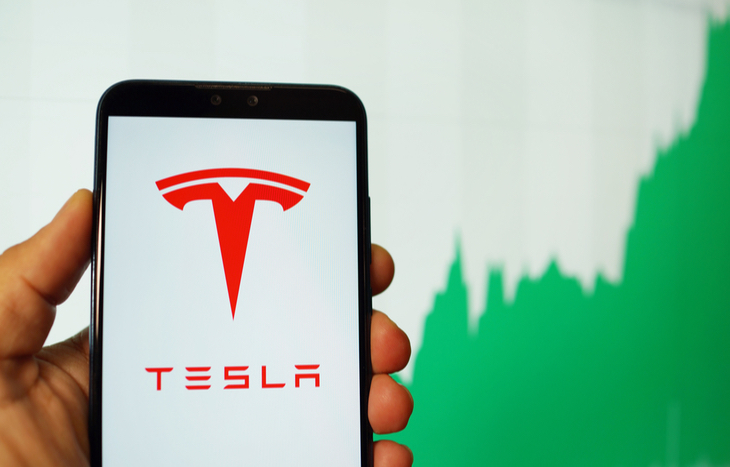What is Tesla’s Market Share?
In the age of mega-cap companies, only a few have managed to break the trillion-dollar mark. Apple (Nasdaq: AAPL) was the first to do it, followed by Microsoft (Nasdaq: MSFT) and Amazon (Nasdaq: AMZN). Not far behind these monolithic companies is Tesla (Nasdaq: TSLA): the fifth-largest public company in the United States. This article will examine Tesla’s market share.
The big difference between Tesla and these other companies? Tesla was founded in 2003, more than a decade after Amazon and Google, and almost 40 years after Apple and Microsoft. In less than a decade, Tesla went from idealistic startup to surpassing $1 trillion in market cap. How? The answer has to do with Tesla’s market share and its unique growth-hacking approach to an emerging market segment.
Here’s a closer look at Tesla’s market share, how it got to be so massive and why it continues to grow larger with each passing year.

A Look at Tesla’s Market Cap and Market Share
Tesla’s market cap is just over $1 trillion (April 2022). It has annual revenues of $53.82 billion and income of $5.52 billion. It’s the most valuable automotive manufacturer in the world, with a market cap that’s more than four times its largest competitor in Toyota.
Yet, despite these astounding figures, Tesla’s share of the total automotive market is just over 2%. How is this possible? Well, for starters, market cap and market share are two different metrics. In terms of vehicles produced (market share), Tesla puts out about a million vehicles per year worldwide. By comparison, General Motors (NYSE: GM) produced 2.5 vehicles in 2020 and Toyota produced roughly two million. Of the vehicles on the road, Tesla represents a small fraction.
Now, narrow the scope of market share to only electric vehicles and it’s a different story. As of 2021, Tesla controls more than 60% of the world’s EV market. In the automotive market, Tesla is a small fish in a big pond. In the growing EV market, the company is a whale.
How Did Tesla’s EV Market Share Get So Big?
Understanding Tesla’s market share starts by understanding the market for electric vehicles (EVs). The first mass-produced hybrid vehicle was the Toyota Prius, which debuted in 1997 in Japan and went global in 2000. However, at that point, no domestic auto manufacturer had any intentions of producing an EV. Just a few years later, Elon Musk and Tesla came along, recognizing the potential for EVs as the future of the automobile industry.
By focusing explicitly on EVs, Tesla was able to get a major jumpstart on owning market share in a niche that didn’t yet exist. For the better part of a decade, the company focused on engineering a new-age, mass-produced EV and, in 2010, debuted its Model S. At this point, the company had not only a market-ready EV product, but an affordable one.
The introduction of a sleek, competitive EV wasn’t what allowed Tesla to zoom past other automakers. It’s continued innovation. The company’s Autopilot system was the impetus for self-driving cars. Its research into battery technology has paved the way for extreme efficiency. Its electric motor and powertrains are industry-leading. These competitive advantages allowed Tesla not only to capture significant market share, but to create the market it currently dominates today.
Market Share Through Different Lenses
The concept of market share is one that’s viewed through many lenses. On a broad scale, Tesla’s market share is most easily compared to other general automakers. In a more specific capacity, investors might look at Tesla’s market share from an EV manufacturing standpoint. More and more, the market is beginning to stack up Tesla against luxury automakers.
For investors to truly understand Tesla’s market share, they need to identify their thesis. What is Tesla to you? A general automaker? An EV manufacturer? A luxury automotive brand? While it has representation in all three of these verticals, evaluating its performance means looking at what segment of each market it controls based on your thesis.
For example, if you see Tesla as a luxury automotive brand, you’ll be happy to know that it overtook Mercedes-Benz’s top-three spot in U.S. luxury-car registrations in the third quarter of 2021. However, as an EV manufacturer, Tesla’s market share fell roughly 13% from Q2 of 2020 to Q2 of 2021. It gained market share in one sense and lost in another. Recognizing this can help investors better-evaluate the company based on their thesis for its role in a given market.
A Complex Stock to Evaluate
Tesla is often the subject of fierce debate among investors. Not only is it one of the most-hyped stocks (as proven by its trillion dollar valuation), it’s also one of the most-shorted. Even institutional investors struggle to evaluate Tesla’s market cap vs. its market share. Many still see it as a traditional automaker, one that’s more than four times larger than its closest competitor. Others view it as the de-facto EV producer in a market with exponential growth prospects. There’s disagreement about what Tesla’s market is, which leads to confusion about its market share and, inevitably, its market cap.
The fact is, no matter how you view Tesla, it’s fundamentally two things. First, it’s growing by leaps and bounds within a market that it effectively created. Second, it’s valued very highly based on financial benchmarks. The lens through which you choose to look at its market makes all the difference in justifying these variables against Tesla’s market share.





